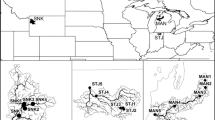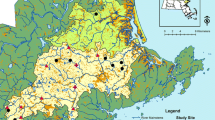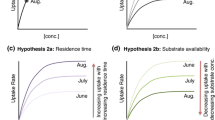Abstract
Some aquatic systems have disproportionately high nutrient processing rates, and may be important to nutrient retention within river networks. However, the contribution of such biogeochemical hot spots also depends on water residence time and hydrologic connections within the system. We examined the balance of these factors in a comparative study of nitrate (NO3 −) uptake across stream and flow-through wetland reaches of northern Wisconsin, USA. The experimental design compared NO3 − uptake at different levels: the ecosystem level, for reaches (n = 9) consisting of morphologically contrasting subreaches (SLOW, low mean water velocity; REF, reference, or higher mean water velocity); the sub-ecosystem level, for subreaches consisting of morphologically contrasting zones (TS, transient storage zone; MC, main channel zone). SLOW subreaches had 45% lower ecosystem-level uptake rate (K, t−1) on average, indicating reduced uptake efficiency in flow-through wetlands relative to streams. The four largest K values (total n = 24) also occurred in REF subreaches. TS:MC uptake rate varied (range 0.1–6.0), but MC zones consistently accounted for most NO3 − uptake by the ecosystem. In turn, TS influence was limited by a tradeoff between TS zone uptake rate and the strength of TS–MC hydrologic connection (α or F med). Additional modeling of published hydrologic parameter sets showed that strong MC dominance of uptake (>75% of total uptake), at the scale of solute release methods (meters to kilometers, hours to days), is common among streams and rivers. Our results emphasize that aquatic nutrient retention is the outcome of a balance involving nutrient uptake efficiency, water residence time, and the strength of hydrologic connections between nutrient sources and sinks. This balance restricts the influence of hydrologically disconnected biota on nutrient transport, and could apply to diverse ecosystem types and sizes.





Similar content being viewed by others
References
Atkinson MJ, Bilger RW. 1992. Effects of water velocity on phosphate-uptake in coral reef-flat communities. Limnol Oceanogr 37(2):273–9.
Bencala KE, Walters RA. 1983. Simulation of solute transport in a mountain pool-and-riffle stream—a transient storage model. Water Resour Res 19(3):718–24.
Borchardt MA. 1996. Nutrients. Algal Ecology. San Diego: Academic Press. pp 184–227.
Bormann FH, Likens GE. 1979. Catastrophic disturbance and the steady-state in northern hardwood forests. Am Sci 67(6):660–9.
Briggs MA, Gooseff MN, Arp CD, Baker MA. 2009. A method for estimating surface transient storage parameters for streams with concurrent hyporheic storage. Water Resour Res 46(4):W00D27.
Briggs MA, Gooseff MN, Peterson BJ, Morkeski K, Wollheim WM, Hopkinson CS. 2010. Surface and hyporheic transient storage dynamics throughout a coastal stream network. Water Resour Res 46(6):W06516.
Demars BOL. 2008. Whole-stream phosphorus cycling: testing methods to assess the effect of saturation of sorption capacity on nutrient uptake length measurements. Water Res 42(10–11):2507–16.
Earl SR, Valett HM, Webster JR. 2006. Nitrogen saturation in stream ecosystems. Ecology 87(12):3140–51.
Earl SR, Valett HM, Webster JR. 2007. Nitrogen spiraling in streams: comparisons between stable isotope tracer and nutrient addition experiments. Limnol Oceanogr 52(4):1718–23.
Ensign SH, Doyle MW. 2005. In-channel transient storage and associated nutrient retention: evidence from experimental manipulations. Limnol Oceanogr 50(6):1740–51.
Essington TE, Carpenter SR. 2000. Nutrient cycling in lakes and streams: insights from a comparative analysis. Ecosystems 3(2):131–43.
Findlay S. 1995. Importance of surface-subsurface exchange in stream ecosystems—the hyporheic zone. Limnol Oceanogr 40(1):159–64.
Fisher J, Acreman MC. 2004. Wetland nutrient removal: a review of the evidence. Hydrol Earth Syst Sci 8(4):673–85.
Fisher SG, Gray LJ, Grimm NB, Busch DE. 1982. Temporal succession in a desert stream ecosystem following flash flooding. Ecol Monogr 52(1):93–110.
Gantzer CJ, Rittmann BE, Herricks EE. 1988. Mass-transport to streambed biofilms. Water Res 22(6):709–22.
Gerard VA. 1982. In situ water motion and nutrient uptake by the giant kelp Macrocystis pyrifera. Mar Biol 69:51–4.
Gooseff MN, McGlynn BL. 2005. A stream tracer technique employing ionic tracers and specific conductance data applied to the Maimai catchment, New Zealand. Hydrol Process 19(13):2491–506.
Grimm NB, Fisher SG. 1986. Nitrogen limitation in a Sonoran Desert stream. J North Am Benthol Soc 5(1):2–15.
Gucker B, Boechat IG. 2004. Stream morphology controls ammonium retention in tropical headwaters. Ecology 85(10):2818–27.
Hall RO, Tank JL. 2003. Ecosystem metabolism controls nitrogen uptake in streams in Grand Teton National Park, Wyoming. Limnol Oceanogr 48(3):1120–8.
Jansson M, Andersson R, Berggren H, Leonardson L. 1994. Wetlands and lakes as nitrogen traps. Ambio 23(6):320–5.
Jordan SJ, Stoffer J, Nestlerode JA. 2011. Wetlands as sinks for reactive nitrogen at continental to global scales: a meta-analysis. Ecosystems 14(1):144–55.
Kadlec RH, Wallace SD. 2009. Treatment wetlands. Boca Raton (FL): CRC Press. p 1016.
Lightbody AF, Avener ME, Nepf HM. 2008. Observations of short-circuiting flow paths within a free-surface wetland in Augusta, Georgia, USA. Limnol Oceanogr 53(3):1040–53.
McClain ME, Boyer EW, Dent CL, Gergel SE, Grimm NB, Groffman PM, Hart SC, Harvey JW, Johnston CA, Mayorga E et al. 2003. Biogeochemical hot spots and hot moments at the interface of terrestrial and aquatic ecosystems. Ecosystems 6(4):301–12.
McKnight DM, Runkel RL, Tate CM, Duff JH, Moorhead DL. 2004. Inorganic N and P dynamics of Antarctic glacial meltwater streams as controlled by hyporheic exchange and benthic autotrophic communities. J North Am Benthol Soc 23(2):171–88.
Mulholland PJ, Hall RO, Sobota DJ, Dodds WK, Findlay SEG, Grimm NB, Hamilton SK, McDowell WH, O’Brien JM, Tank JL et al. 2009. Nitrate removal in stream ecosystems measured by 15N addition experiments: denitrification. Limnol Oceanogr 54(3):666–80.
Mulholland PJ, Marzolf ER, Webster JR, Hart DR, Hendricks SP. 1997. Evidence that hyporheic zones increase heterotrophic metabolism and phosphorus uptake in forest streams. Limnol Oceanogr 42(3):443–51.
Mulholland PJ, Steinman AD, Marzolf ER, Hart DR, DeAngelis DL. 1994. Effect of periphyton biomass on hydraulic characteristics and nutrient cycling in streams. Oecologia 98(1):40–7.
Mulholland PJ, Tank JL, Webster JR, Bowden WB, Dodds WK, Gregory SV, Grimm NB, Hamilton SK, Johnson SL, Martí E et al. 2002. Can uptake length in streams be determined by nutrient addition experiments? Results from an interbiome comparison study. J North Am Benthol Soc 21(4):544–60.
Munk WH, Riley GA. 1952. Absorption of nutrients by aquatic plants. J Mar Res 11:215–40.
Naiman RJ, Melillo JM. 1984. Nitrogen budget of a subarctic stream altered by beaver (Castor-canadensis). Oecologia 62(2):150–5.
O’Brien JM, Dodds WK. 2010. Saturation of NO3- uptake in prairie streams as a function of acute and chronic N exposure. J North Am Benthol Soc 29(2):627–35.
Orr CH, Clark JJ, Wilcock PR, Finlay JC, Doyle MW. 2009. Comparison of morphological and biological control of exchange with transient storage zones in a field-scale flume. J Geophys Res Biogeosci 114:G02019.
Parker HS. 1981. Influence of relative water motion on the growth, ammonium uptake, and carbon and nitrogen composition of Ulva lactuca (Chlorophyta). Mar Biol 63:309–18.
Powers SM, Stanley EH, Lottig NR. 2009. Quantifying phosphorus uptake using pulse and steady-state approaches in streams. Limnol Oceanogr Methods 7:498–508.
Runkel RL. 1998. One dimensional transport with inflow and storage (OTIS): a solute transport model for streams and rivers. Report nr 98-4018.
Runkel RL. 2002. A new metric for determining the importance of transient storage. J North Am Benthol Soc 21(4):529–43.
Runkel RL. 2007. Toward a transport-based analysis of nutrient spiraling and uptake in streams. Limnol Oceanogr Methods 5:50–62.
Schalchli U. 1992. The clogging of coarse gravel river beds by fine sediment. Hydrobiologia 235:189–97.
Schumacher GJ, Whitford LA. 1965. Respiration and P32 uptake in various species of freshwater algae as affected by a current. J Phycol 1:78–80.
Seitzinger S, Harrison JA, Bohlke JK, Bouwman AF, Lowrance R, Peterson B, Tobias C, Van Drecht G. 2006. Denitrification across landscapes and waterscapes: a synthesis. Ecol Appl 16(6):2064–90.
Stream Solute Workshop. 1990. Concepts and methods for assessing solute dynamics in stream ecosystems. J North Am Benthol Soc 9(2):95–119.
Tank JL, Rosi-Marshall EJ, Baker MA, Hall RO. 2008. Are rivers just big streams? A pulse method to quantify nitrogen demand in a large river. Ecology 89(10):2935–45.
Thomas FIM, Atkinson MJ. 1997. Ammonium uptake by coral reefs: effects of water velocity and surface roughness on mass transfer. Limnol Oceanogr 42(1):81–8.
Thomas SA, Valett HM, Webster JR, Mulholland PJ. 2003. A regression approach to estimating reactive solute uptake in advective and transient storage zones of stream ecosystems. Adv Water Resour 26(9):965–76.
Valett HM, Crenshaw CL, Wagner PF. 2002. Stream nutrient uptake, forest succession, and biogeochemical theory. Ecology 83(10):2888–901.
Valett HM, Dahm CN, Campana ME, Morrice JA, Baker MA, Fellows CS. 1997. Hydrologic influences on groundwater surface water ecotones: heterogeneity in nutrient composition and retention. J North Am Benthol Soc 16(1):239–47.
Valett HM, Morrice JA, Dahm CN, Campana ME. 1996. Parent lithology, surface-groundwater exchange, and nitrate retention in headwater streams. Limnol Oceanogr 41(2):333–45.
Vitousek PM, Aber JD, Howarth RW, Likens GE, Matson PA, Schindler DW, Schlesinger WH, Tilman DG. 1997. Human alteration of the global nitrogen cycle: sources and consequences. Ecol Appl 7(3):737–50.
Vitousek PM, Reiners WA. 1975. Ecosystem succession and nutrient retention—hypothesis. Bioscience 25(6):376–81.
Webster JR, Mulholland PJ, Tank JL, Valett HM, Dodds WK, Peterson BJ, Bowden WB, Dahm CN, Findlay S, Gregory SV et al. 2003. Factors affecting ammonium uptake in streams—an inter-biome perspective. Freshw Biol 48(8):1329–52.
Wetzel RG. 2001. Limnology: lake and river ecosystems. San Diego: Academic Press. 1006 pp.
Wollheim WM, Vorosmarty CJ, Peterson BJ, Seitzinger SP, Hopkinson CS. 2006. Relationship between river size and nutrient removal. Geophys Res Lett 33(6):L06410.
Acknowledgements
Laboratory assistance and field assistance were provided by James Thoyre, Page Mieritz, Justin Zik, Alex Bilgri, James Sustachek, and Colleen Sylvester. Stephen Carpenter provided valuable comments on the manuscript. Work was supported by NSF funding of the North Temperate Lakes Long-term Ecological Research (LTER) Program, and State of Wisconsin Groundwater Research and Monitoring Program (project #WR07R003).
Author information
Authors and Affiliations
Corresponding author
Additional information
Author contributions
Stephen Powers conceived of and designed the study, led the field and laboratory work, analyzed the data, conducted the modeling, and wrote the paper. Robert Johnson contributed substantially to the field work, lab work, and analysis of the data. Emily Stanley contributed substantially to the study design, and writing of the paper.
Electronic supplementary material
Below is the link to the electronic supplementary material.
Rights and permissions
About this article
Cite this article
Powers, S.M., Johnson, R.A. & Stanley, E.H. Nutrient Retention and the Problem of Hydrologic Disconnection in Streams and Wetlands. Ecosystems 15, 435–449 (2012). https://doi.org/10.1007/s10021-012-9520-8
Received:
Accepted:
Published:
Issue Date:
DOI: https://doi.org/10.1007/s10021-012-9520-8




